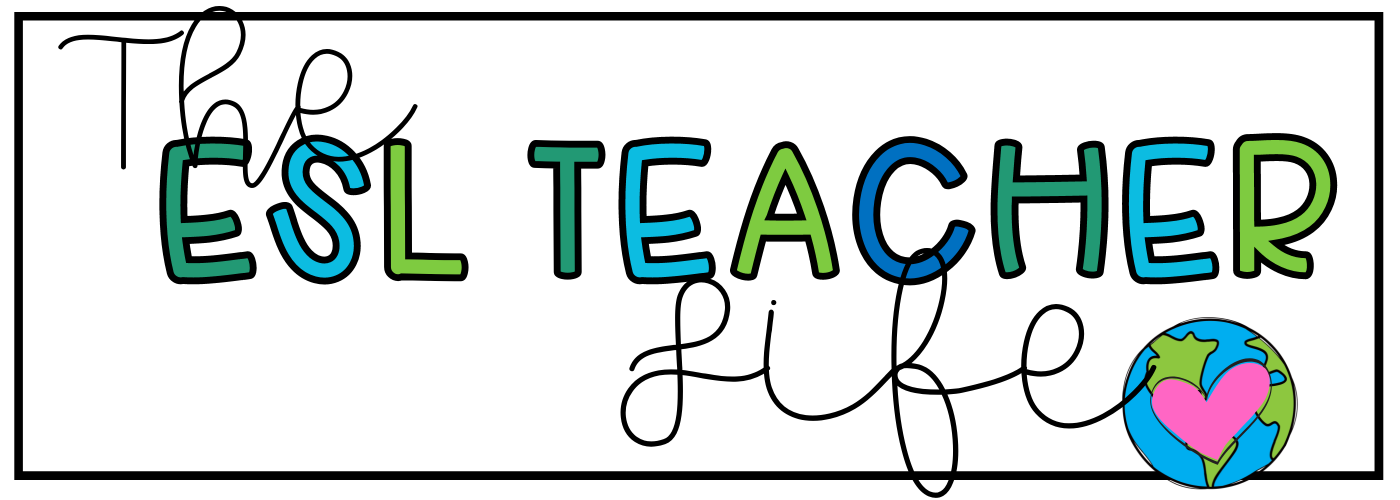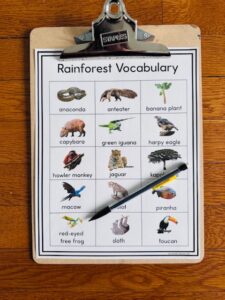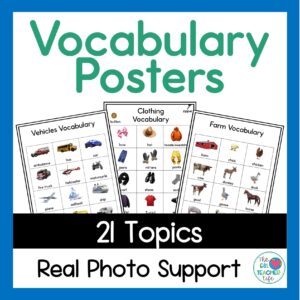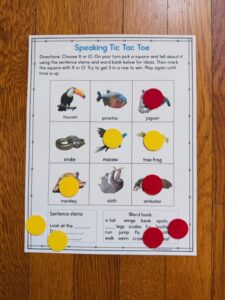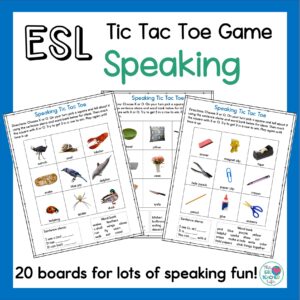Did you know doing research with English learners can build vocabulary, foster curiosity, and improve writing skills? Planning a research unit also gives you a concrete plan for teaching many skills over the course of a couple weeks. Keep reading for tips, strategies, and a ready-to-use Rainforest Animals resource to make research engaging and effective.
Why do research with English learners?
First, let’s take a look at a few important benefits:
Language Development – Research helps students learn and use new words in context.
Critical Thinking – Students learn to ask questions, find answers, and organize ideas.
- Standards based– Covers common core writing research standards with opportunities for modeling and practice to improve writing skills.
- Engagement – Choosing high-interest topics makes learning fun.
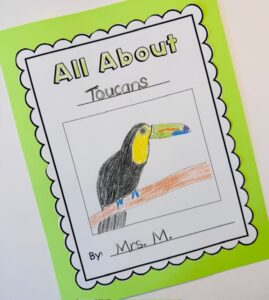
How do I start research with English learners?
Here are some basics using Rainforest Animals research as an example:
Start with pictures – Show images of rainforest animals and ask students what they already know.
- Read high interest books to introduce the rainforest theme and build engagement.
Add sentence starters – Examples: “A jaguar can ___.” “A sloth lives in ___.”
Provide a word bank – Include key vocabulary (e.g., jungle, climb, hunt, predator, nocturnal).
Guide research with simple texts – Use reading passages and books at different levels with real photos.
Model the process – Think aloud as you read and take notes to show how research works.
- Support writers as they move from research to writing individual pages of their books.
- Celebrate the finish product.
How do I organize and plan for research?
To begin, start with a few general rainforest books to build background knowledge and interest. Below you will find a few suggestions. Then, before diving into individual reports, round up books and reading materials on a variety of rain forest animals so you have enough materials for students to use and have students choose from the animals that you have.
Next, choose which animal you as the teacher are interested in so that you will be excited to model research too. Read aloud about that animal. I “think aloud” as I am reading about where it lives and other things about its habitat. I model how to add to my note taking sheet about this and then move on to another such as what it eats. Use sentence frames for support and build in speaking practice. After I model how to read and record information on my note taking sheet, we spend 2-3 days doing research. For Kindergarten and first grade you also have the option to vote on an animal to research as a group and record ideas together on a chart, or it could be done as partners or small groups to share ideas and materials.
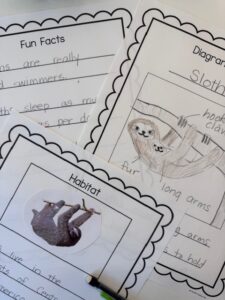
After students have a good start on basic information, review complete sentences and model one page at a time to show them what is expected. It is a great time to teach text features in context. For example, we look at a diagram and notice the labels and title. I have a drawing of my animal ready and I model how I label the body parts using my book for support and then how I use my note taking sheet to tell about at least one of the body parts. We continue this way for each page of the student books.
If you are doing shared research students can still complete their own pages or different students can be responsible for different pages. As students or groups are working, you can support them with questioning and discussion. Finally, be sure to celebrate the process of finding new information and asking questions as well as the finished product. Keep reading for more resources!
Books to Introduce the rainforest theme
- The Great Kapok Tree by Lynne Cherry – Introduces rainforest animals and the importance of their habitat
Rainforest Animals by Paul Hess – Short poems about rainforest animals.
- Rainforest Animals (Who Am I?) by Read with You – A very short guessing book with one fact about each animal.
- Who Lives Here? Rain Forest Animals by Deborah Hodge – An overview of several rain forest animals and their adaptations.
National Geographic Kids: Rainforests by Andrea Silen – Excellent introduction with wonderful photographs.
Favorite Series for Individual Animals
Search for: Bumba Books, PebbleGo books, and National Geographic Kids books.
Helpful Websites & Digital Tools
National Geographic Kids – Short articles and videos
PBS Learning Media – Videos and interactive resources
epic! – Free rainforest-themed books for teachers with a classroom account
Tips for Making Research Fun & Accessible
Use Videos & Real Photos – The three resources listed above are great for this.
Incorporate Hands-On Learning – Act out how animals move, use props, or create mini-dioramas.
Pair Students for Support – Partner beginners with more advanced students.
Add Speaking and Writing Scaffolds– Anchor charts, sentence strips, and graphic organizers help.
Celebrate Student Work – Display research projects in a “Rainforest Experts” classroom corner, let students visit other classrooms and read aloud to younger students, or hang books in the hallway for all to see.
Research Builds Lifelong Learners
To make this process easier for you, I have a rainforest resource on TPT.
Here’s what’s Included:
Simple research template
Sentence starters and writing scaffolds
2 options for reading passages about seven rainforest animals
- Pages for a student made book

What teachers are saying: “This was a great activity for my students to practice their reading and writing skills. The students found the animal topics interesting and enjoyed learning additional facts about each one. “
More resources you might like:
You also might like to add the following resources to your plans. Use the rain forest animals vocabulary sheet from the vocabulary posters resource to introduce animals
At the end of the unit, let students share their research books on different animals. Then play the rainforest animal tic tac toe game in pairs to show what they know about each animal.
